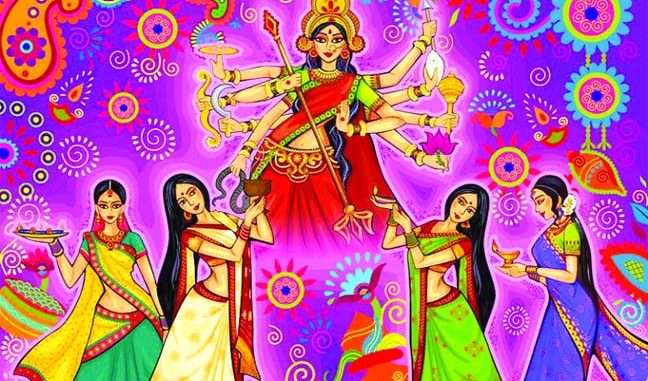
Navratri is a nine days festival dedicated to Goddess Durga. Navratri is a Sanskrit word which literally means nine nights. During these nine nights and ten days, Goddess Durga is worshipped in 9 different forms, known as Navdurga. The tenth day is celebrated as Vijayadashami when idols of Goddess Durga are immersed into the water body.
Navratri is celebrated in most Indian states. However Navratri is very popular festival in the western states of Gujarat, Maharashtra and the southern state of Karnataka. On the very first day of Navratri, Goddess Durga is invoked into a Kalash with full Vedic rituals along with chanting of Mantras. The invocation and dwelling of Goddess Durga into the Kalash is known as Ghatasthapana or Kalashsthapana and is done at an appropriate time of the day.
In West Bengal Navratri is celebrated as Durga Puja. In West Bengal, Goddess Durga is worshipped on the last three days of Navratri and these three days are famously known as Durga Saptami, Durga Ashtami and Durga Navami. It would be correct to say that Durga Puja in West Bengal is a smaller version of 9 days Navratri. Kalparambha and Bilva Nimantran during Durga Puja, which is done on the sixth day of Navratri, is symbolically same as Ghatasthapana or Kalashsthapana in other states.
Hindu religious books suggest 7 days Navratri, 5 days Navratri, 3 days Navratri, 2 days Navratri or even 1 day Navratri as an alternative to 9 days Navratri.
Jyoti Kalash, Kumari Puja, Sandhi Puja, Navami Homa, Lalitha Vrat and Chandi Path are other famous rituals and events which are observed during 9 days Navratri.
Navratri literally means ‘nine nights’ and it is one of the most significant Hindu festivals that will be observed from October 7th this year. This auspicious occasion will last till October 15th.
On October 15/16, Vijayadashami also known as Dussehra will be celebrated. It marks the end of Navaratri every year. During Navaratri, devotees worship nine forms of Goddess Durga namely Shailaputri, Brahmacharini, Chandraghanta, Kushmanda, Skanda Mata, Katyayani, Kalaratri, Mahagauri, and Siddhidatri.
Navratri 2021 Dates
– On October 7, on Pratipada tithi, Ghatasthapana and Shailputri Puja will be performed.
– On October 8 on Dwitiya tithi, Brahmacharini Puja should be performed.
– On October 9 on Tritiya and Chaturthi, Chandraghanta Puja and Kushmanda Puja should be performed.
– On October 10 for Panchami tithih Skandamata Puja should be performed.
– On October 11, for Sashti tithi Katyayani Puja should be performed.
– On October 12, Saptami tithi, perform Kalaratri Puja
– On October 13, Ashtami tithi perform Maha Gauri Puja
– On October 14, Navami tithi perform Siddhidhatri Puja
– On October 15, Dashami tithi perform Navratri Parana/Durga Visarjan
Significance
It is believed that Lord Shiva granted permission to his wife Goddess Durga for seeing her mother for just nine days. During that time, Goddess Durga demolished demon Mahishasura. Hence Goddess Durga aka Kali is represented as a symbol of shakti – the ultimate strength. It is also said that Maa Durga has eternal divine power, which can never be created nor destroyed.
Importance
Throughout the nine nights, nine forms of the goddess are worshiped with much grandeur. On the 10th day, which is October 8 this year, people celebrate Vijayadashami means Dusshera by burning huge effigies of Ravana, Meghnad and Kumbhakarna. Thus, Navratri itself symbolises victory over evil.
Celebrations
During these nine nights of Navratri, people observe fast. Cultural programs are organised, people depict the story of Lord Rama. On the eighth day, Kanya Pujan is observed in which minor girls are worshipped and offered prashad, food and sweets. All over the country Dandiya and Garba programmes are organised by community people.
Durga Puja
Predominantly celebrated in the states of West Bengal, Assam, Tripura, Odisha, and Bihar, Durga Puja happens to be one of the biggest festivals for Bengalis. The festival celebrates Goddess Durga’s triumph over the demon, Mahishasura. Though it’s a 10-day festival, the last five days are considered to be the most significant ones. Other than Goddess Durga, deities of Saraswathi, Lakshmi, Ganesha, and Karthik are also worshipped.
This year, Durga Puja will begin onMonday, 11 October, and end on Friday, 15 October.
Significance of Durga Puja
As per Hindu mythology, the festival marks Goddess Durga’s visit to her natal home along with her children. Durga Puja is preceded by Mahalaya, which marks the beginning of Durga’s journey to her home. The actual puja starts from “Maha Sashthi” or the sixth day where devotees welcome the Goddess with pomp and gusto. On this day, Durga’s deity is unveiled in front of the public. Several rituals are performed while the “dhakis” keep the mood and spirit of the puja alive by playing the “dhak”—a kind of drum that’s associated with the puja and Bengali culture.
The 7th day marks the commencement of “Maha Saptami”. On this day, just before dawn, a banana tree is immersed in the water as a part of the ritual. After the ceremonial bath, the tree or “Kola Bou” (as called in Bengali) is draped in a saree, usually a red-bordered one, and placed on the right-side of Ganesha, thereby implying that “Kola Bou” is actually the bride of Ganesha. However, several cultural revisionists and historians have different views on this as some believe that “Kola Bou” is another representation of Durga. Hence, they refute the theory that “Kola Bou” is the bride of Ganesha.
Another different view is that “Kola Bou” is a symbolic representation of nine types of plants that form a sacred complex. Priests tie a bunch of eight plants on the trunk of the banyan tree before performing the ritual. The nine different leaves combined together form “Kola Bou”—often considered as the plant form of Durga.
“Maha Ashtami” marks the 8th of the puja and is considered as the day when the Goddess defeated “Mahisasura”. Prayers are offered in the form of “Anjali” while feasts are organised in different localities. Khichdi and other delicacies are prepared on this day.
The 9th day is dubbed as “Maha Navami”. As soon as the “Sandhi Puja” ends, Maha Navami commences. Maha Aarti is performed as a closing ritual. Huge queues are common on this day as people flock in to take part in “Maha Aarti”.
The 10th day or “Maha Dashami” marks the final day of Durga Puja. On this day, Durga and the other deities are immersed in the river Ganga. Before the immersion, married women take part in “Sindoor Khela” where they smear vermillion on each other’s faces. On the day of immersion, also called “Visarjan”, huge processions are common. People dance and cheer on the road to celebrate the spirit of the puja. After the immersion, a typical custom is followed where people visit their relatives’ house to wish “Bijoya Dashami”.





Be the first to comment